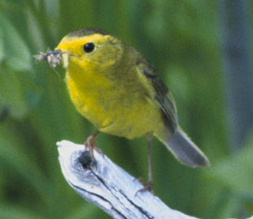Wilson's Warbler
|
|
| Wilson's Warbler | ||||||||||||||
|---|---|---|---|---|---|---|---|---|---|---|---|---|---|---|
 | ||||||||||||||
| Scientific classification | ||||||||||||||
| ||||||||||||||
| Binomial name | ||||||||||||||
| Wilsonia pusilla (Wilson,, 1811) |
The Wilson's Warbler, Wilsonia pusilla, is a New World warbler. It breeds in northern North America across Canada and south through the western USA.
It is migratory, wintering in Central America. This is a very rare vagrant to western Europe.
The Wilson's Warbler has a plain green-brown back and yellow underparts. The male has a small black cap. Males of the western race W. p. chryseola are greener above and brighter than the eastern race.
The breeding habitat is fairly open woodlands with undergrowth or shrubs. Wilson's Warblers nest on the ground, laying 4-6 eggs in a cup nest.
These birds feed on insects, often caught by flycatching.
The song is a series of descending notes. The call is a loud chif.
This bird was first described in 1811 by the American ornithologist Alexander Wilson, who gave his own name to the genus.
Reference
New World Warblers by Curson, Quinn and Beadle, ISBN 0-7136-3932-6
